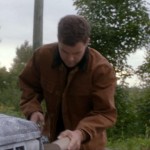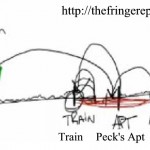The new Fringe episode, And Those We’ve
Left Behind, made me think of the 2nd season episode White Tulip.
And Those We’ve Left Behind is like White
Tulip in that someone wants to change time to get their loved one back,
and they end up killing others in the process. In the end of both these episodes
they find they can accept things as they originally happened and love their
spouses like they are (by dying with them, or by caring for their Alzheimer’s
self). Walter was the same in that he couldn’t accept what time first gave him
in Peter’s death; he wanted to change the universe to travel to an alternate
world and get a new son.
The time jumps with Peter and the Greens in this episode were not linear but
more circular like in White Tulip. A machine is used to go back to the same
place again and again, that is where the loops develop. For example; two
different things happen in the same situation. He examines the train area then
they drive away verses his he touches car then appears back in their driving
vehicle. Like in White Tulip each time loop adds on to the previous loop and
also takes the place of the previous loop; like the book having the writing from
before plus a little more, or the Dr. Peck gaining more Faraday implants each
time. I’ve made a diagram of the time loops in And Those We’ve Left Behind it is in the pictures above.
I got my Fringe episode pictures here.
You can also read this post on LiveJournal here.
Please leave your thoughts on time loops as well. Are there any more time loops in Fringe? Is there a different way to explain them? What causes them?
Thanks, Heather From Utah










I thought, the story of the couple was more directed to Peter. In the end, the husband reads the message of his wife, that he has to go on with his life and that he has to love her the way she is now. There is a parallel to peter’s life. The people, he loved have changed and he can’t turn that back. He has to accept and love them as they are now and go on with his life. The old timeline won’t come back.
Great Post Heather!
But my favorite thing is that River Song is your avatar on your livejournal.
HELLO SWEETIE !!!!!!
Time loops are interesting and time loops are fun but the thing with time loops you’re always back where you started from. (There’s a poem in there someplace.)
What I am afraid of is Fringe “time looping” itself as a series. The episodes taken individually are brilliant but as a whole it is ground we have covered before like, as you said, with White Tulip and this particular episode. I’d rather see Fringe take to places we’ve never been before.
I’ve had a similar thought as well, Inter-dimensional Dave. This season is like looking back on season one in many ways, with first meetings between characters etc.
Yes, hints of a book “The Lathe of Heaven”, (on the ‘Lost’ reading reading list`, it’s worth noting), “…a 1971 science fiction novel by Ursula K. Le Guin. The plot revolves around a character whose dreams alter reality.”- thanks, Wiki, Though that was more overt, being the main plot device of the book.
Viewpoints
I’m shamelessly stealing bits from wiki here (because I suck at summarizing and they don’t). But these bits hopefully show why I think it’s a relevant book for Fringe fans to reference to for guessing where the plot might be going, and why…at least in elements of it. It’s a great book, and has had several film adaptations.
The Lathe of Heaven “…Though technology plays a minor role, the novel is largely concerned with philosophical questions about our desire to control our destiny,…The book is critical of behaviorism……..utilitarianism, …Le Guin may have named her protagonist “George Orr” as an homage to British author George Orwell, as well as to draw comparisons between the dystopic worlds she describes in Lathe, and the dystopia Orwell envisioned in his novel 1984.[11]…”
As the plot evolves….“ ..coherent existence is dissolving into undifferentiated chaos –…..random bits of the various recent realities …get jumbled together…”
I haven’t seen any ovetr references to dreams altering reality in fringe, but definitely to mental/psychic forces affecting it…anyway, I like the connections I see…is there a ‘Fringe’ reading list? I’ve been away for a while (in the Whoverse…), just getting back into the swing of fringes- er, I mean, of things.
If by a Fringe reading list you mean real books mentioned on the show you can find a list here: http://fringepedia.net/wiki/Books